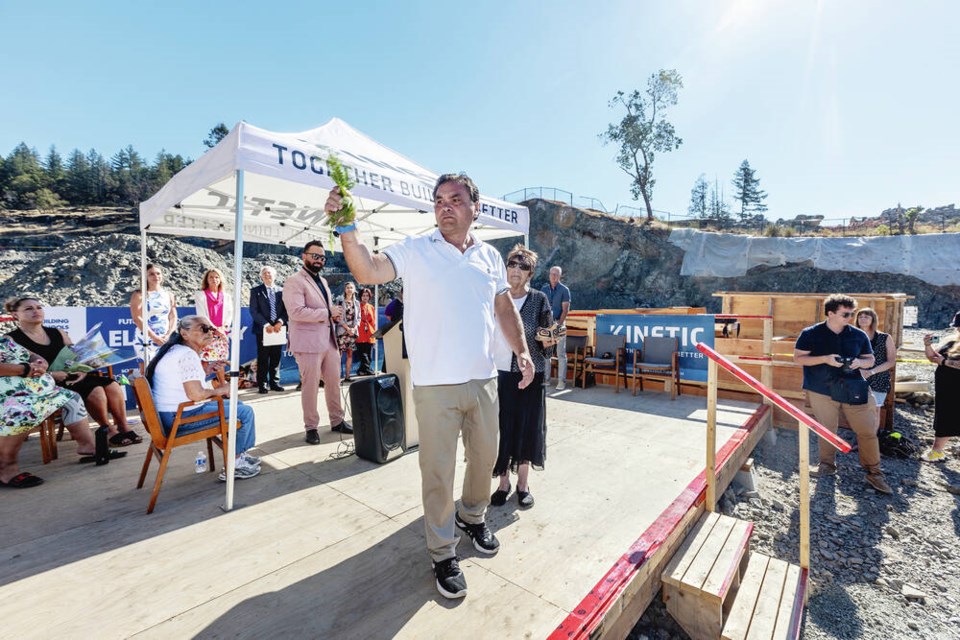The Indigenous name of the Sooke School District’s newest facility was presented at a Monday event by Sc’ianew First Nation elder and knowledge keeper Lavina Charles, who noted it might be a challenge for some people to pronounce at first.
The name is SĆIȺNEW̱ SṮEȽIṮḴEȽ, which means “salmon children” in English and reflects important aspects of Sc’ianew culture. The pronunciation is “schee-ay-nuh ska-leetk-luth.”
“We are extremely proud to gift this name to the Sooke School District,” said Sc’ianew Chief Russ Chipps, who is also a Sooke School Board trustee.
He said that Charles led the search for a name “that reflected our culture and a place for learning.”
“SĆIȺNEW̱ represents the richness of the sea life in our region that sustains our land and people,” Chipps said at the event, at the school’s Latoria Road site. “SṮEȽIṮḴEȽ is one of the most important words in the SENĆOŦEN language because it means children and, in our culture, they are our most precious resource.”
People can learn the pronunciation of the school’s name with practice, Chipps said.
“I think it’s the epitome of what reconciliation is, learning the language, walking together, not just a territorial acknowledgement.”
Charles said the naming of the school is very meaningful to her.
“I’m so glad that it’s happening because I went through hell in school,” she said. “In school, I was told not to use my church, my words, everything else that made me who I am.
“Together, we are learning the language of this land that was forgotten by force, and I hope a school name in our language makes it better for not only our children but all children.”
Coming together is a vital part of making life better, Charles said.
“All our people are important; they are part of this land; they are part of this country,” she said. “There is nothing wrong with being an Indian and there is nothing wrong with being white. Smarten up and really start thinking of this world, this earth.”
The school district said in a statement that it views choosing the new name as a commitment “that the painful and ugly history of educational institutions will not be forgotten, and that schools can and will be places of healing and hope.”
Interim school board chair Amanda Dowhy said the district “is committed to walking the path of reconciliation.”
“Our students and families who make up the traditional territories of our district should see and feel their culture throughout our school communities,” she said. “And it is equally important for those of us who are visitors on these territories to take the time to learn more about the rich culture that has existed here for generations.”
The new $39.6-million elementary school will accommodate 480 students in kindergarten-Grade 5. Construction is underway and is scheduled for completion in September 2025.
Sooke district superintendent Scott Stinson said the school will be “much-needed” for families in the neighbourhood.
“We are seeing continued rapid growth in our school district.”
The name was chosen after broad community consultation and discussions with Indigenous groups.
“A gifted name from one of the local First Nations was one of the most popular selections from those who participated in the process,” Dowhy said.
Former board chair Ravi Parmar, who now represents the area as MLA for Langford-Juan de Fuca, said he is honoured that being part of the naming decision was one of the last things he did as a board member.
He called the naming announcement “a significant and meaningful milestone.”
Minister of Indigenous Relations and Reconciliation Murray Rankin said the school’s name is fitting and appropriate.
“Think about the iconic importance of salmon to Indigenous people.”
He said that reconciliation with Indigenous people “is at the heart of everything we’re doing as a government.”
The school district also chose Indigenous names for its two most recently completed schools, which opened last year. They are PEXSISEN Elementary School, whose name means “the opening of hands” in the Songhees language, and Centre Mountain Lellum Middle School, with “Lellum” gifted by the Sc’ianew and meaning “house and the idea of community, where we raise our children.”
About 10 per cent of the district’s over 12,000 students are Indigenous, including those who are Métis and Inuit. The three predominant First Nations are T’Sou-ke, Pacheedaht and Sc’ianew, while some district schools are on the traditional territory of the Esquimalt and Songhees Nations.
>>> To comment on this article, write a letter to the editor: [email protected]



